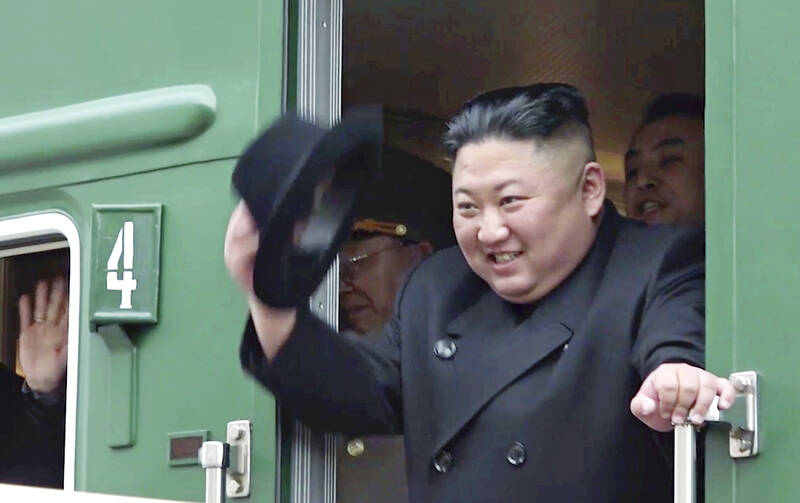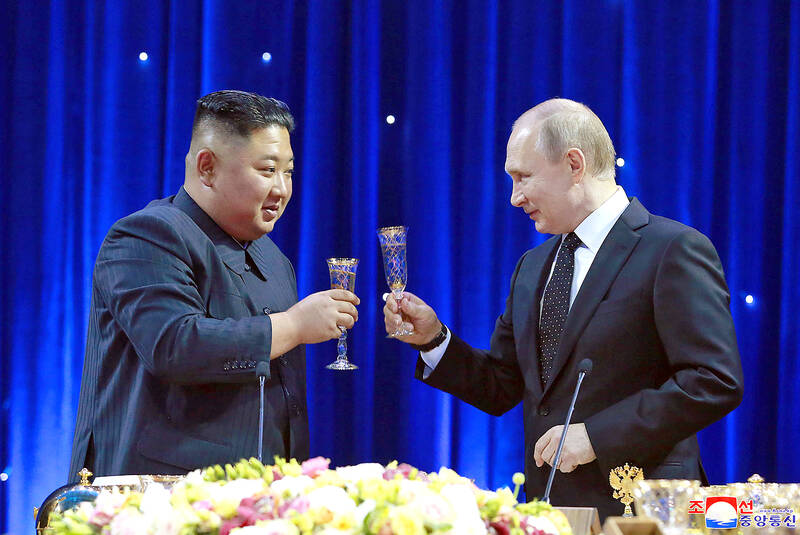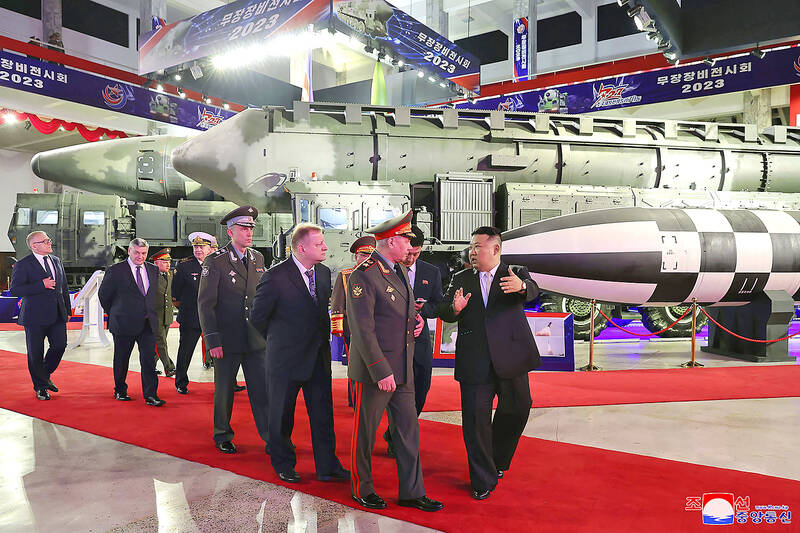North Korean leader Kim Jong-un’s possible trip to Russia might be like his first one in 2019 — a rattling, 20-hour ride aboard a green-and-yellow armored train that is a quirky symbol of his family’s dynastic leadership.
In what would be his first foreign travel since the start of the pandemic, US officials say Kim may visit Russia this month for a meeting with Russian President Vladimir Putin, possibly to advance talks on North Korean arms sales to refill Russian reserves drained by its war on Ukraine.
According to US reports, a potential venue for their meeting is the eastern city of Vladivostok, the site of their first meeting in April 2019, where Putin is expected to attend the annual Eastern Economic Forum that takes place on the campus of the Far Eastern Federal University from Sunday to Wednesday.

Photo: AP
How Kim, the 39-year-old authoritarian leader, would get there is a focus of media attention.
While Kim has used planes more frequently than his famously flight-averse father, he has also used his family’s armored train for his previous meetings with Putin, Chinese President Xi Jinping (習近平), and then-US President Donald Trump in 2018 and 2019, reviving an old symbol that has long been part of the Kim dynasty’s lore.
Putin, for his part, now prefers to avoid airplanes and travel on a special armored train since his decision to invade Ukraine early last year, according to Gleb Karakulov, a defector from Putin’s secretive elite security service.

Photo: AP
Kim’s earlier meeting with Putin required a daylong trip that began at the North Korean capital of Pyongyang and chugged over the country’s aging railways along the eastern coast before crossing a border river into Russia.
Kim went to China four times from 2018 to 2019 to meet Xi — two of them by his train and the other two by his private Russian-made jet. In June 2018, he borrowed a Chinese Boeing 747 plane to fly to Singapore for his first summit with Trump, reportedly because his jet was deemed unsafe. For his second meeting with Trump in February 2019 in Hanoi, Vietnam, Kim took his train for a two-and-half day trip.
Kim’s meetings with Xi and Putin surrounded his high-stakes diplomacy with Trump, where he attempted to leverage his nukes for badly needed economic benefits. The Kim-Trump diplomacy eventually collapsed after their Hanoi meeting.

Photo: AP
Since closing his country’s borders in early 2020 to guard against the COVID-19 pandemic, Kim hasn’t met any foreign leader.
Kim’s possible second trip to Russia could signal a restart of a summit-driven diplomacy and may be followed by a trip to China for a meeting with Xi, said Yang Moo-jin, president of the University of North Korean Studies in South Korea.
Kim’s father, Kim Jong-il, made about a dozen trips abroad during his 17-year rule, almost all to China and all by train. North Korea’s state media said that Kim Jong-il died of a heart attack during a train trip in 2011.
According to an account published in 2002 by Konstantin Pulikovsky, a Russian official who accompanied Kim Jong-il on a three-week trip to Moscow a year earlier, the train carried cases of expensive French wine and passengers could feast on live lobster and pork barbeque.
The train’s most important feature, however, would be security. According to South Korean media reports, North Korea has 90 special carriages in total and operates three trains in tandem when a leader is traveling — an advance train to check the rails, the train with the leader and his immediate entourage, and a third train behind for everyone else. High-tech communication equipment and flat-screen TVs are installed so a leader can give orders and receive briefings.
A life-size mock-up of one of the train’s carriages is on permanent display at a mausoleum on the outskirts of Pyongyang where Kim Jong-il and his state-founding father, Kim Il-sung, lie in state.
It’s not immediately clear whether Kim Jong-un would choose to travel to Russia on a train again when he seems equally comfortable with flying. When Kim jetted off to the northeastern Chinese city of Dalian in May 2018 for his second meeting with Xi, he became the first North Korean leader to fly abroad in 32 years. The last time a North Korean leader had publicly gone abroad by air had been Kim Il-sung’s flight to the Soviet Union in 1986.
Schooled for several years in Switzerland, Kim Jong-un is believed to have traveled by air often as a teenager. Since taking office upon his father’s death in December 2011, Kim had also occasionally flown inside North Korea. Kim’s official plane is a remodeled version of the Soviet-made IL-62. North Korea calls it “Chammae-1,” named after the goshawk, North Korea’s national bird.
South Korean media say the plane can fly at a maximum speed of 900km per hour and carry about 200 people. Its maximum flight range is about 9,200km but it has reportedly never flown that far. State media said Kim was aboard Chammae-1 when he reviewed air force planes taking part in combat aeronautics contests and inspected construction work in Pyongyang.
Some analysts are skeptical whether Kim’s meeting with Putin would happen next week on the sidelines of the Eastern Economic Forum because he and his predecessors have preferred one-on-one summitry when making their rare trips abroad.
Still, there are growing expectations for a meeting as it’s clear Kim’s and Putin’s interests are aligning in the face of their deepening, separate confrontations with the US.

That US assistance was a model for Taiwan’s spectacular development success was early recognized by policymakers and analysts. In a report to the US Congress for the fiscal year 1962, former President John F. Kennedy noted Taiwan’s “rapid economic growth,” was “producing a substantial net gain in living.” Kennedy had a stake in Taiwan’s achievements and the US’ official development assistance (ODA) in general: In September 1961, his entreaty to make the 1960s a “decade of development,” and an accompanying proposal for dedicated legislation to this end, had been formalized by congressional passage of the Foreign Assistance Act. Two

Despite the intense sunshine, we were hardly breaking a sweat as we cruised along the flat, dedicated bike lane, well protected from the heat by a canopy of trees. The electric assist on the bikes likely made a difference, too. Far removed from the bustle and noise of the Taichung traffic, we admired the serene rural scenery, making our way over rivers, alongside rice paddies and through pear orchards. Our route for the day covered two bike paths that connect in Fengyuan District (豐原) and are best done together. The Hou-Feng Bike Path (后豐鐵馬道) runs southward from Houli District (后里) while the

March 31 to April 6 On May 13, 1950, National Taiwan University Hospital otolaryngologist Su You-peng (蘇友鵬) was summoned to the director’s office. He thought someone had complained about him practicing the violin at night, but when he entered the room, he knew something was terribly wrong. He saw several burly men who appeared to be government secret agents, and three other resident doctors: internist Hsu Chiang (許強), dermatologist Hu Pao-chen (胡寶珍) and ophthalmologist Hu Hsin-lin (胡鑫麟). They were handcuffed, herded onto two jeeps and taken to the Secrecy Bureau (保密局) for questioning. Su was still in his doctor’s robes at

Mirror mirror on the wall, what’s the fairest Disney live-action remake of them all? Wait, mirror. Hold on a second. Maybe choosing from the likes of Alice in Wonderland (2010), Mulan (2020) and The Lion King (2019) isn’t such a good idea. Mirror, on second thought, what’s on Netflix? Even the most devoted fans would have to acknowledge that these have not been the most illustrious illustrations of Disney magic. At their best (Pete’s Dragon? Cinderella?) they breathe life into old classics that could use a little updating. At their worst, well, blue Will Smith. Given the rapacious rate of remakes in modern